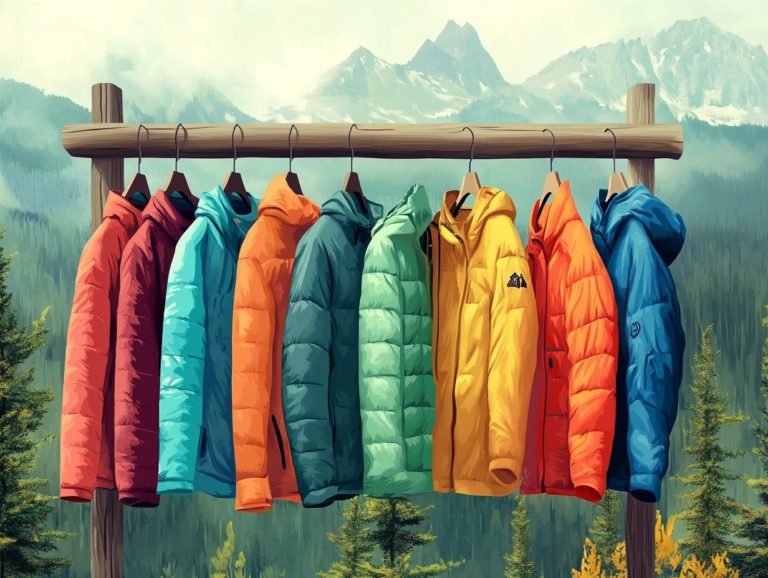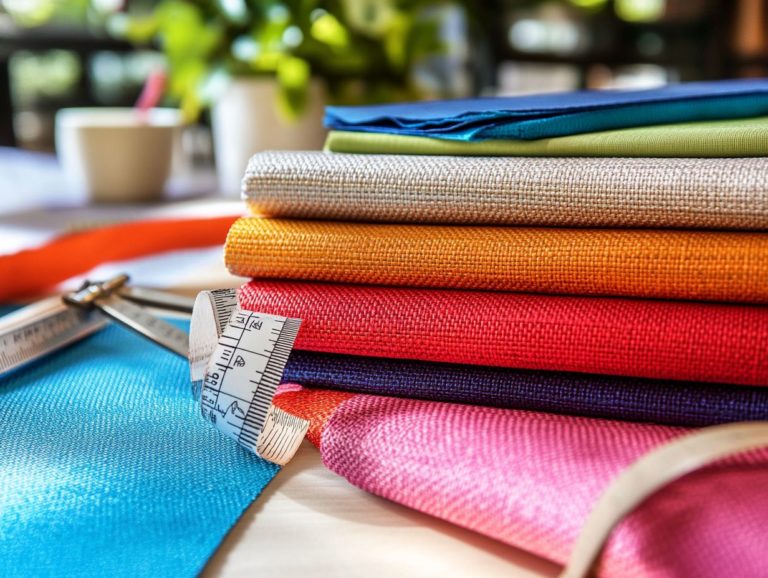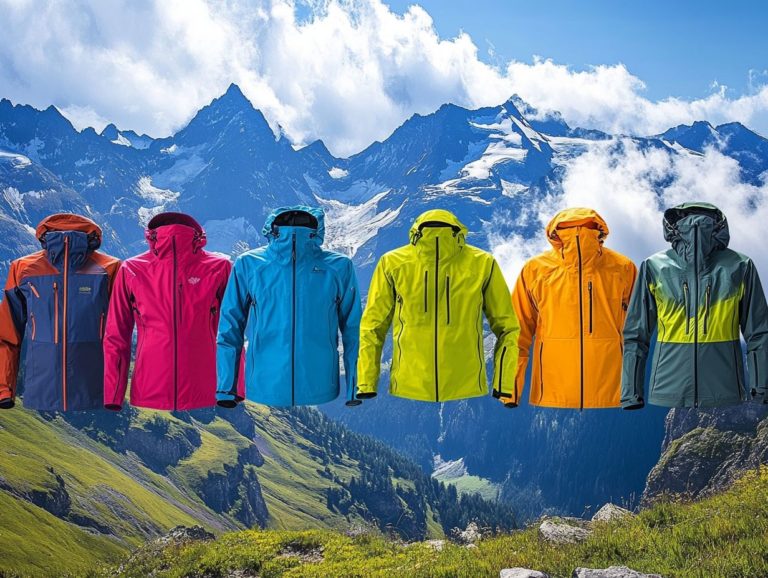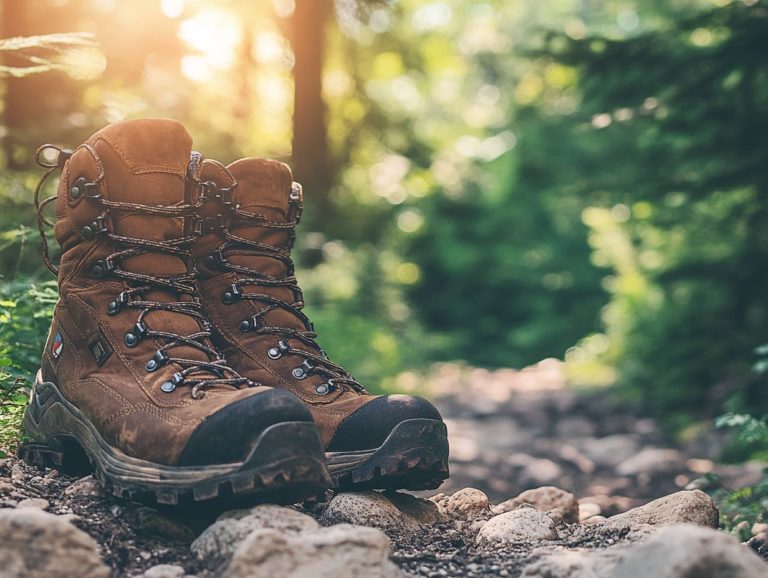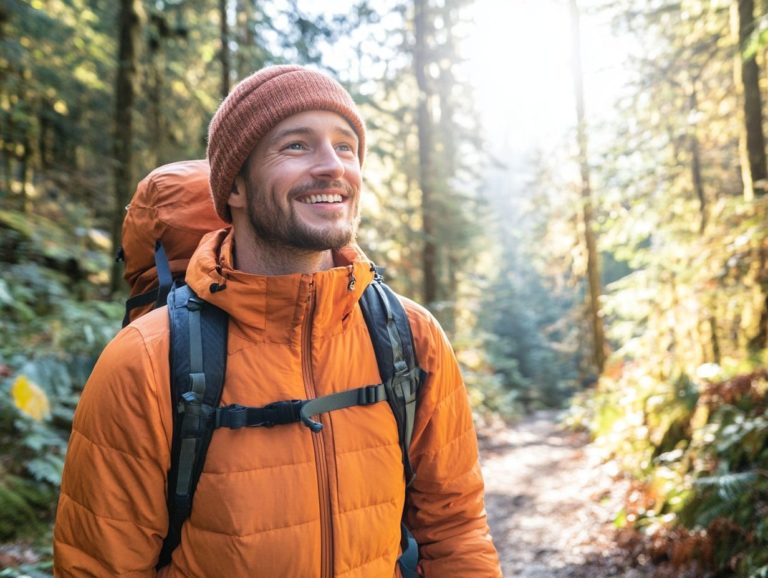Choosing the Right Outdoor Clothing for Your Adventure
Selecting the right outdoor clothing can truly make or break your adventure, whether you’re navigating mountain trails or savoring a weekend camping escapade.
With various factors to consider such as weather, activity, and terrain it s crucial to understand how each element affects your gear choices.
This guide will navigate you through the nuances of layering for optimal comfort, highlight the must-have materials, and lay out best practices for maintaining your outdoor wardrobe.
Get ready to conquer the outdoors with the right gear!
Contents
Key Takeaways:
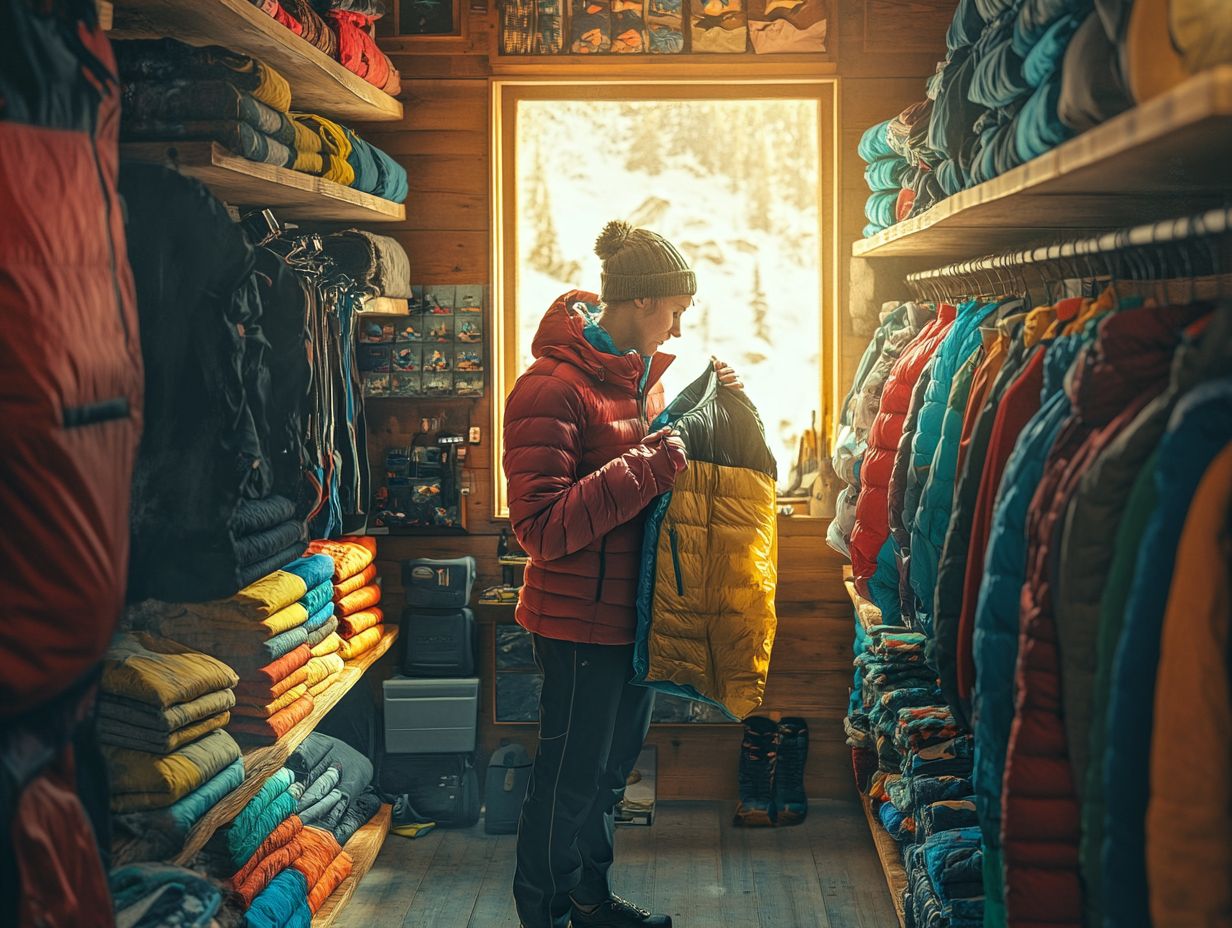
- Consider the weather and terrain when choosing outdoor clothing to ensure proper protection and comfort.
- Layering is key for optimal comfort and protection. Choose a base, mid, and outer layer with appropriate materials and features.
- Taking care of your clothes, like washing and storing them properly, will help them last longer.
Factors to Consider When Choosing Outdoor Clothing
Choosing the right outdoor clothing requires a clear understanding of several key factors that can greatly influence your experience. Consider aspects such as weather conditions, terrain, and the specific activities you intend to undertake.
Opting for high-quality gear, like fabrics that pull sweat away from your skin, is crucial for maintaining both comfort and performance. Make sure your outdoor gear aligns with your needs, such as choosing the right backpack, to elevate your experience.
An informed selection truly has the power to transform your outdoor adventures.
Weather and Climate
Understanding the weather conditions is essential when choosing your outdoor clothing; different climates demand specific types of gear to ensure your comfort and protection during adventures.
For instance, in hot and humid environments, you’ll want breathable materials that allow sweat to evaporate. This makes moisture-wicking shirts and lightweight shorts your best allies. On the flip side, when you re up against cold or wet conditions, insulated jackets paired with waterproof pants become absolutely essential for keeping your body heat and dryness intact.
Even during those tricky transitional seasons, layering is key. Start with a moisture-wicking base layer, add an insulating mid-layer, and top it off with a waterproof shell this combination offers you optimal versatility.
Don t underestimate the importance of footwear, either. Waterproof hiking boots are your go-to for wet trails, while breathable sneakers are perfect for drier terrains. Ultimately, being well-prepared means selecting the right attire that can adapt to varying weather forecasts, ensuring that every outdoor experience is both enjoyable and safe.
Activity and Terrain
The type of activity and terrain you plan to navigate plays a pivotal role in determining your choice of outdoor gear, from hiking boots to camping essentials, ensuring you re fully equipped for any adventure that comes your way.
Selecting the right gear not only enhances your safety but also maximizes your comfort during outdoor pursuits. For instance, sturdy hiking boots are crucial for tackling rugged trails, providing the support and traction you need on uneven surfaces.
When you embark on overnight trips, lightweight tents and sleeping bags become essential for ensuring a restful night beneath the stars. Proper layering with moisture-wicking clothing keeps you comfortable through fluctuating weather conditions.
A well-thought-out hydration system be it a reliable water bottle or a convenient hydration pack is vital for maintaining your energy levels. Staying hydrated is key to boosting your overall performance and health during outdoor excursions.
Don t wait make sure you re prepared for any adventure that may come your way!
Layering for Optimal Comfort and Protection
A well-structured layering system is vital for achieving optimal comfort and protection during your outdoor adventures. This approach enables you to adapt seamlessly to fluctuating weather conditions and varying levels of exertion.
Typically, this system encompasses a base layer crafted from moisture-wicking fabric to efficiently manage sweat, an insulating mid-layer for added warmth, and an outer layer designed to shield you from wind and rain. Each component plays a pivotal role in regulating your body temperature and enhancing your overall comfort, allowing you to fully enjoy your pursuits in nature.
Base Layer
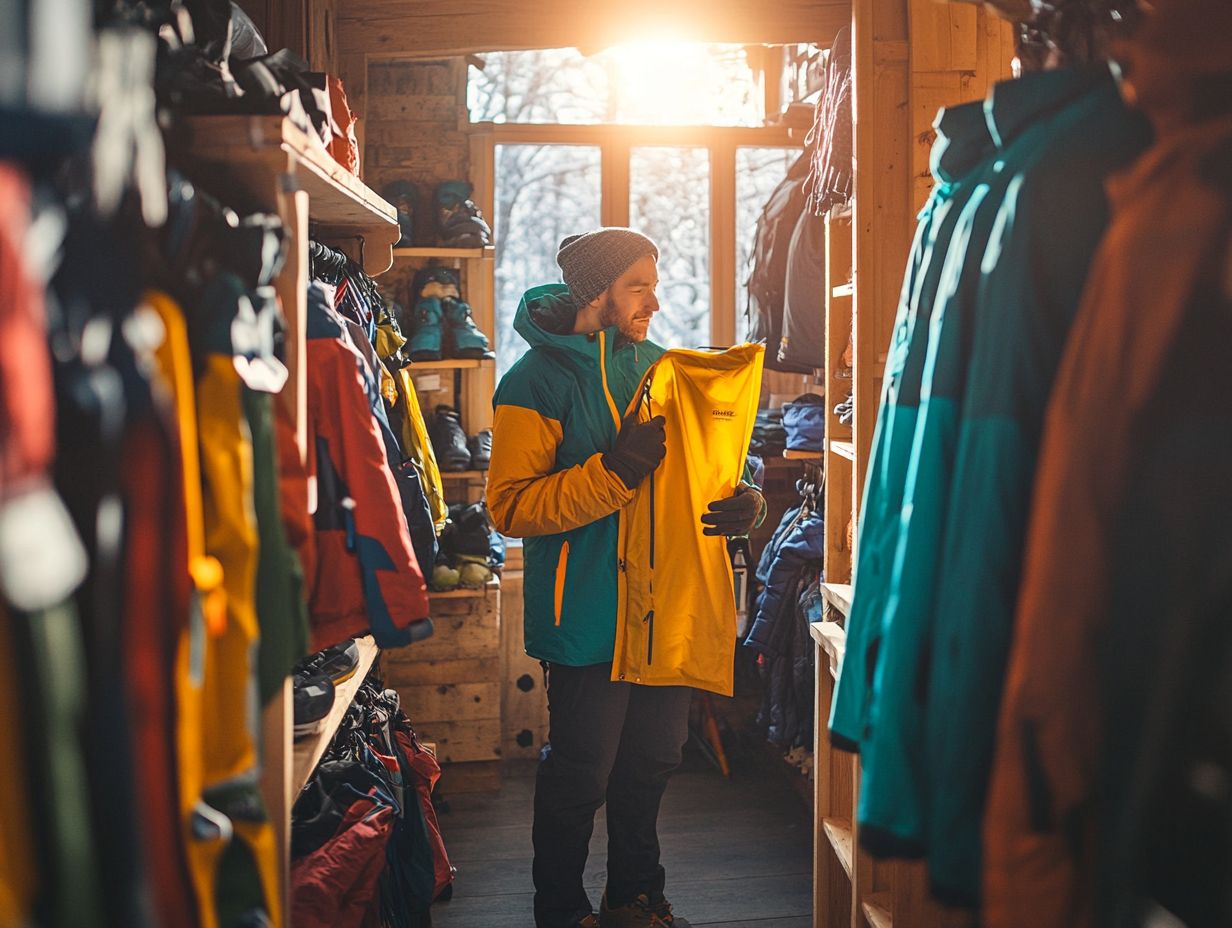
The base layer is a cornerstone of your layering system. It manages moisture and ensures comfort during outdoor activities.
Crafted from materials like moisture-wicking fabric, synthetic textiles, or soft merino wool, it excels at keeping sweat away.
Not only does it whisk moisture away from your skin, but it also helps regulate body temperature, making it versatile for different climates. For example, you might prefer synthetic fabrics for high-intensity activities such as trail running</b, where you navigate rugged paths at speed, or cycling, where breathability and rapid drying are paramount. On the other hand, if you’re venturing into colder environments, merino wool provides exceptional insulation and natural odor resistance, making it an ideal companion for skiing or snowshoeing.
By carefully selecting the right base layer to meet the specific demands of your outdoor adventures, including features such as moisture-wicking fabric and breathable materials, you can elevate both your comfort and performance. For instance, choosing the right socks for outdoor activities can make a significant difference in your overall experience.
Mid Layer
The mid layer is your secret weapon for insulation, providing warmth and comfort during your outdoor adventures. Typically crafted from lightweight materials, it effectively traps heat without adding unnecessary bulk.
The mid layer buffers moisture from the base layer and protects against the outer shell, which stands guard against wind and precipitation.
In terms of insulation options, you re in luck there s a wide variety available. Cozy fleece is perfect for moderate temperatures, offering breathability, while down is renowned for its exceptional warmth-to-weight ratio, making it your go-to for colder climates and vigorous activities.
As you select your mid layer, think carefully about the specific activity and weather conditions. If you’re hiking in mild weather, a fleece pullover may be all you need. However, for those braving frigid temperatures while skiing, a down jacket is a smart choice to keep you warm and comfortable throughout your journey.
Outer Layer
The outer layer protects you from rain, wind, and snow. Waterproof gear is a must-have for your outdoor adventures!
Selecting the right materials can significantly impact not only your comfort but also your overall performance during outdoor activities. For example, breathable fabrics allow moisture to escape, helping you regulate your body temperature and stay dry from perspiration while providing a crucial barrier against unpredictable weather.
When your outer layer is expertly crafted to withstand various conditions, managing hydration and temperature becomes remarkably easier. Therefore, choosing outdoor clothing for kids that is weather-appropriate is vital for ensuring that you stay focused and can fully enjoy your excursions without discomfort.
Materials and Features to Look For
When choosing outdoor clothing, focus on waterproofing, breathability, and durability. High-quality materials enhance performance, keeping you comfortable and protected in any weather.
Waterproof and Breathability
Waterproof gear is essential in outdoor clothing. It provides protection against moisture, while breathability ensures your comfort by allowing sweat to escape. This balance is crucial for anyone who enjoys outdoor activities, whether it’s hiking or skiing.
Take, for instance, technologies like Gore-Tex. They empower you to stay dry from external rain or snow, while preventing overheating during heart-pounding moments of exertion.
When selecting outdoor apparel, remember to consider not just the fabric’s waterproof rating but also the rate at which sweat can escape. This rate is crucial for maintaining comfort during activities like hiking and climbing.
By understanding these features, you can choose gear that optimizes your performance. This ensures you remain comfortable and protected in unpredictable environments.
Insulation
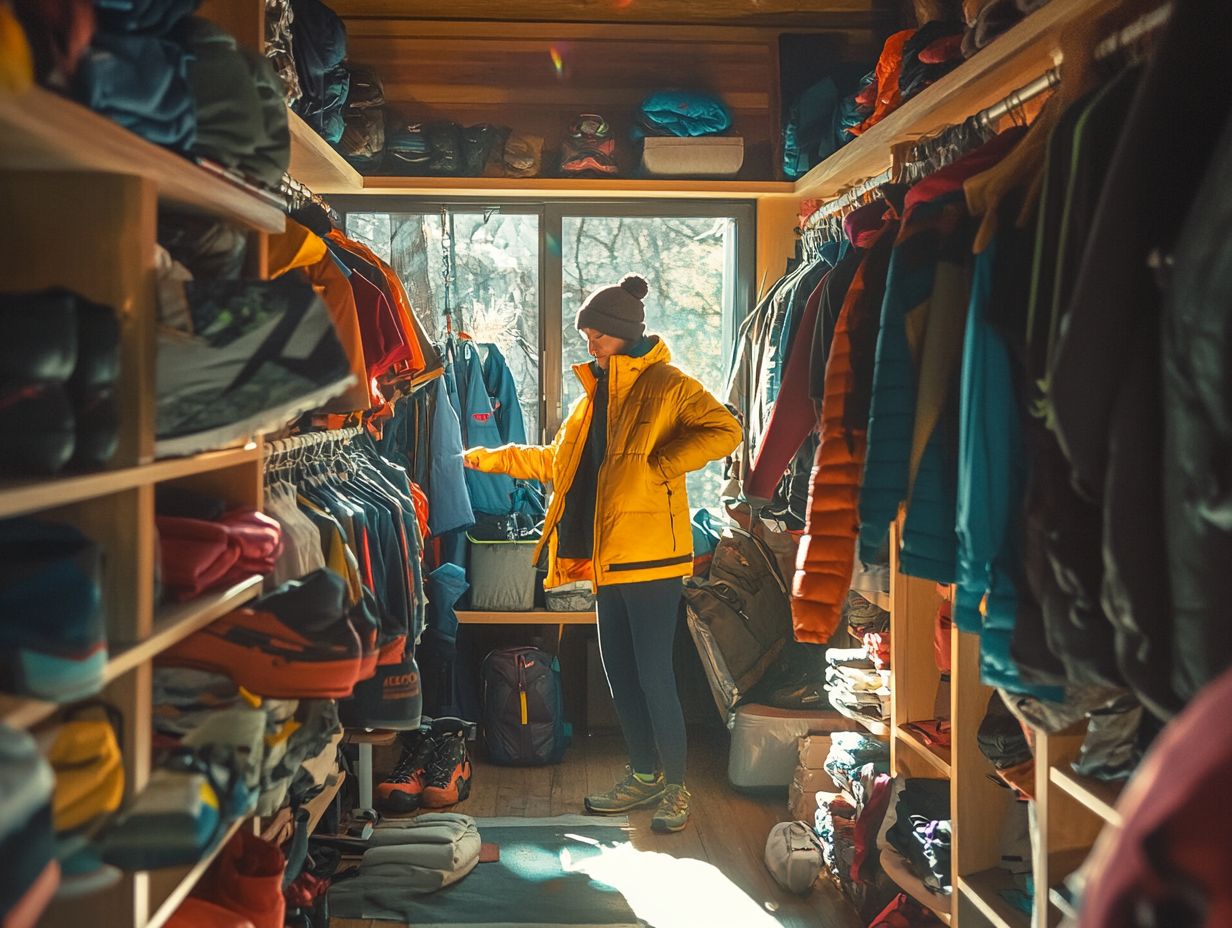
Insulation is an essential aspect of outdoor gear. It offers warmth and comfort in cold conditions, and it deserves careful consideration based on your planned activity and layering system.
Explore various types of insulation. Down, synthetic, and fleece materials each have unique advantages and drawbacks.
Down insulation is celebrated for its remarkable warmth-to-weight ratio, making it perfect for frigid, dry environments. However, it loses its insulating power when it gets wet.
On the other hand, synthetic insulation maintains its effectiveness even in damp conditions. This makes it a solid choice for wetter climates, although it can be bulkier and heavier.
Fleece, while not the most thermally efficient option, excels as a mid-layer. It offers breathability and quick drying times for high-energy pursuits.
Don t wait! Choosing the right insulation can elevate your outdoor experience, whether you re trekking through snowy mountains or enjoying crisp fall evenings.
Durability
Durability is paramount when selecting outdoor gear. Top-notch materials and construction methods can significantly extend the lifespan of your moisture-wicking clothing and other essentials.
As you embark on various outdoor activities be it hiking, camping, or climbing it’s crucial to opt for gear that can endure the rigors of wear and tear.
Seek out fabrics like nylon or polyester, renowned for their strength and abrasion resistance. Construction techniques such as reinforced stitching and double-layer panels add an extra layer of durability.
To guarantee longevity, consider the specific conditions you’ll encounter. Choose gear tailored for particular environments and pay attention to reviews from fellow outdoor enthusiasts. For those seeking inspiration, check out the best climbing gear for outdoor adventures. Your adventures deserve equipment that can keep pace with your passion.
Proper Care and Maintenance of Outdoor Clothing
Taking proper care and maintenance of your outdoor clothing is crucial for extending the lifespan and performance of your gear. By doing so, you ensure that it remains effective and comfortable throughout your outdoor adventures.
This includes mastering the right washing and drying techniques, as well as employing suitable storage methods that shield your gear from damage and wear.
Washing and Drying Techniques
Washing and drying techniques are essential for maintaining your outdoor gear, especially moisture-wicking clothing. Improper care can diminish both performance and durability, and that s the last thing you want.
To keep these critical garments functioning at their best, it’s crucial to select detergents specifically formulated for technical fabrics. Typically, cold water washes are recommended, as higher temperatures can compromise the integrity of synthetic fibers.
Avoid fabric softeners at all costs; they can clog those important moisture-wicking properties your clothing relies on.
In terms of drying, air drying is often your safest bet for preserving elasticity and fit, although low-heat tumble drying may work for some items. By consistently following these best practices, you can significantly extend the life of your outdoor apparel.
Storage and Preservation
Storage and preservation play a crucial role in ensuring the longevity of your outdoor gear. Improper storage can lead to damage and degradation of materials over time. Don’t let your gear go to waste! Store it properly to keep it in top shape!
To extend the life of your essential items, make it a priority to keep them in a cool, dry place, away from direct sunlight and humidity. These conditions can encourage the growth of mold and mildew. Consider using breathable garment bags for your clothing and clear plastic bins with lids for smaller gear. This approach prevents moisture build-up and allows you to see everything at a glance.
Set up a designated gear rack or shelving to keep everything organized and easily accessible. This makes your prep for the next adventure both efficient and enjoyable. Adding simple labels to your bins can streamline the process, ensuring you find exactly what you need without sifting through clutter.
Frequently Asked Questions
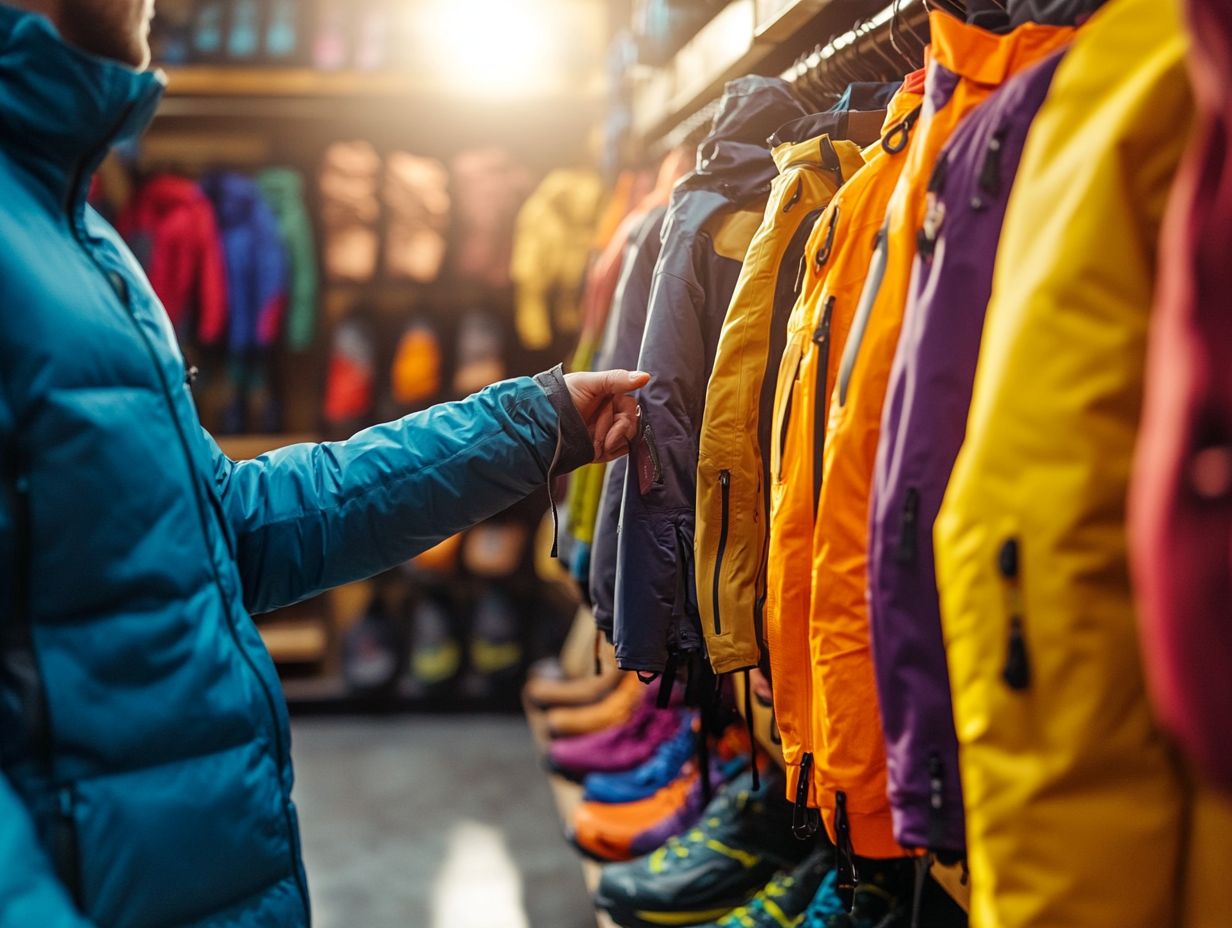
Choosing Outdoor Clothing: Key Factors
When choosing outdoor clothing, consider factors such as weather conditions, activity level, and personal preferences. Ensure you have the appropriate clothing for the environment and the level of physical exertion involved.
Importance of Material in Outdoor Adventures
The material of your clothing is crucial as it can affect your comfort and performance. Look for materials that breathe well, dry quickly, and keep you comfortable, such as nylon, polyester, or merino wool.
Function vs. Fashion in Outdoor Clothing
In outdoor adventures, function should always take priority over fashion. Your clothing should protect you from the elements and allow for comfortable movement. There are many stylish options that are also functional!
Essential Outerwear for Hiking Trips
For a hiking trip, bring a waterproof and windproof jacket to protect against sudden weather changes and keep dry in case of rain. Look for jackets with adjustable hoods, pockets, and ventilation options.
Staying Warm in Cold Weather
Layering is key for warmth in cold weather. Start with a moisture-wicking base layer, add an insulating mid-layer, and finish with a waterproof outer layer. This approach keeps you warm while allowing freedom of movement.
Essential Items for Camping Trips
For a camping trip, bring versatile and functional clothing that can be layered. Essential items include:
- A warm and waterproof jacket
- Moisture-wicking base layers
- Comfortable and durable pants
- A good pair of hiking boots
Get ready for your adventure with the right gear!

